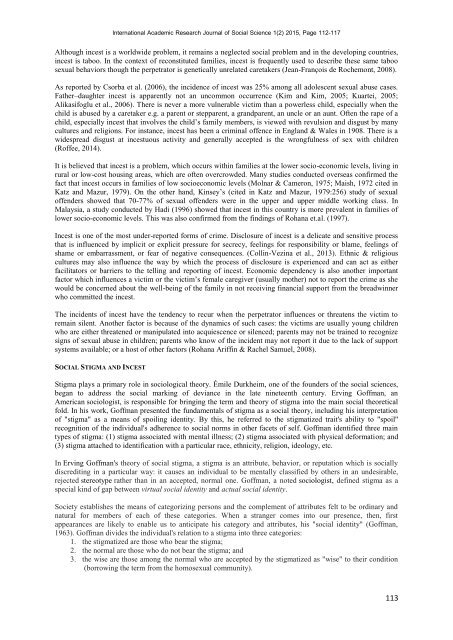Social Stigma of Incest in Malaysia
17-P112-117
17-P112-117
Create successful ePaper yourself
Turn your PDF publications into a flip-book with our unique Google optimized e-Paper software.
International Academic Research Journal <strong>of</strong> <strong>Social</strong> Science 1(2) 2015, Page 112-117<br />
Although <strong>in</strong>cest is a worldwide problem, it rema<strong>in</strong>s a neglected social problem and <strong>in</strong> the develop<strong>in</strong>g countries,<br />
<strong>in</strong>cest is taboo. In the context <strong>of</strong> reconstituted families, <strong>in</strong>cest is frequently used to describe these same taboo<br />
sexual behaviors though the perpetrator is genetically unrelated caretakers (Jean-François de Rochemont, 2008).<br />
As reported by Csorba et al. (2006), the <strong>in</strong>cidence <strong>of</strong> <strong>in</strong>cest was 25% among all adolescent sexual abuse cases.<br />
Father–daughter <strong>in</strong>cest is apparently not an uncommon occurrence (Kim and Kim, 2005; Kuartei, 2005;<br />
Alikasifoglu et al., 2006). There is never a more vulnerable victim than a powerless child, especially when the<br />
child is abused by a caretaker e.g. a parent or stepparent, a grandparent, an uncle or an aunt. Often the rape <strong>of</strong> a<br />
child, especially <strong>in</strong>cest that <strong>in</strong>volves the child’s family members, is viewed with revulsion and disgust by many<br />
cultures and religions. For <strong>in</strong>stance, <strong>in</strong>cest has been a crim<strong>in</strong>al <strong>of</strong>fence <strong>in</strong> England & Wales <strong>in</strong> 1908. There is a<br />
widespread disgust at <strong>in</strong>cestuous activity and generally accepted is the wrongfulness <strong>of</strong> sex with children<br />
(R<strong>of</strong>fee, 2014).<br />
It is believed that <strong>in</strong>cest is a problem, which occurs with<strong>in</strong> families at the lower socio-economic levels, liv<strong>in</strong>g <strong>in</strong><br />
rural or low-cost hous<strong>in</strong>g areas, which are <strong>of</strong>ten overcrowded. Many studies conducted overseas confirmed the<br />
fact that <strong>in</strong>cest occurs <strong>in</strong> families <strong>of</strong> low socioeconomic levels (Molnar & Cameron, 1975; Maish, 1972 cited <strong>in</strong><br />
Katz and Mazur, 1979). On the other hand, K<strong>in</strong>sey’s (cited <strong>in</strong> Katz and Mazur, 1979:256) study <strong>of</strong> sexual<br />
<strong>of</strong>fenders showed that 70-77% <strong>of</strong> sexual <strong>of</strong>fenders were <strong>in</strong> the upper and upper middle work<strong>in</strong>g class. In<br />
<strong>Malaysia</strong>, a study conducted by Hadi (1996) showed that <strong>in</strong>cest <strong>in</strong> this country is more prevalent <strong>in</strong> families <strong>of</strong><br />
lower socio-economic levels. This was also confirmed from the f<strong>in</strong>d<strong>in</strong>gs <strong>of</strong> Rohana et.al. (1997).<br />
<strong>Incest</strong> is one <strong>of</strong> the most under-reported forms <strong>of</strong> crime. Disclosure <strong>of</strong> <strong>in</strong>cest is a delicate and sensitive process<br />
that is <strong>in</strong>fluenced by implicit or explicit pressure for secrecy, feel<strong>in</strong>gs for responsibility or blame, feel<strong>in</strong>gs <strong>of</strong><br />
shame or embarrassment, or fear <strong>of</strong> negative consequences. (Coll<strong>in</strong>-Vez<strong>in</strong>a et al., 2013). Ethnic & religious<br />
cultures may also <strong>in</strong>fluence the way by which the process <strong>of</strong> disclosure is experienced and can act as either<br />
facilitators or barriers to the tell<strong>in</strong>g and report<strong>in</strong>g <strong>of</strong> <strong>in</strong>cest. Economic dependency is also another important<br />
factor which <strong>in</strong>fluences a victim or the victim’s female caregiver (usually mother) not to report the crime as she<br />
would be concerned about the well-be<strong>in</strong>g <strong>of</strong> the family <strong>in</strong> not receiv<strong>in</strong>g f<strong>in</strong>ancial support from the breadw<strong>in</strong>ner<br />
who committed the <strong>in</strong>cest.<br />
The <strong>in</strong>cidents <strong>of</strong> <strong>in</strong>cest have the tendency to recur when the perpetrator <strong>in</strong>fluences or threatens the victim to<br />
rema<strong>in</strong> silent. Another factor is because <strong>of</strong> the dynamics <strong>of</strong> such cases: the victims are usually young children<br />
who are either threatened or manipulated <strong>in</strong>to acquiescence or silenced; parents may not be tra<strong>in</strong>ed to recognize<br />
signs <strong>of</strong> sexual abuse <strong>in</strong> children; parents who know <strong>of</strong> the <strong>in</strong>cident may not report it due to the lack <strong>of</strong> support<br />
systems available; or a host <strong>of</strong> other factors (Rohana Ariff<strong>in</strong> & Rachel Samuel, 2008).<br />
SOCIAL STIGMA AND INCEST<br />
<strong>Stigma</strong> plays a primary role <strong>in</strong> sociological theory. Émile Durkheim, one <strong>of</strong> the founders <strong>of</strong> the social sciences,<br />
began to address the social mark<strong>in</strong>g <strong>of</strong> deviance <strong>in</strong> the late n<strong>in</strong>eteenth century. Erv<strong>in</strong>g G<strong>of</strong>fman, an<br />
American sociologist, is responsible for br<strong>in</strong>g<strong>in</strong>g the term and theory <strong>of</strong> stigma <strong>in</strong>to the ma<strong>in</strong> social theoretical<br />
fold. In his work, G<strong>of</strong>fman presented the fundamentals <strong>of</strong> stigma as a social theory, <strong>in</strong>clud<strong>in</strong>g his <strong>in</strong>terpretation<br />
<strong>of</strong> "stigma" as a means <strong>of</strong> spoil<strong>in</strong>g identity. By this, he referred to the stigmatized trait's ability to "spoil"<br />
recognition <strong>of</strong> the <strong>in</strong>dividual's adherence to social norms <strong>in</strong> other facets <strong>of</strong> self. G<strong>of</strong>fman identified three ma<strong>in</strong><br />
types <strong>of</strong> stigma: (1) stigma associated with mental illness; (2) stigma associated with physical deformation; and<br />
(3) stigma attached to identification with a particular race, ethnicity, religion, ideology, etc.<br />
In Erv<strong>in</strong>g G<strong>of</strong>fman's theory <strong>of</strong> social stigma, a stigma is an attribute, behavior, or reputation which is socially<br />
discredit<strong>in</strong>g <strong>in</strong> a particular way: it causes an <strong>in</strong>dividual to be mentally classified by others <strong>in</strong> an undesirable,<br />
rejected stereotype rather than <strong>in</strong> an accepted, normal one. G<strong>of</strong>fman, a noted sociologist, def<strong>in</strong>ed stigma as a<br />
special k<strong>in</strong>d <strong>of</strong> gap between virtual social identity and actual social identity.<br />
Society establishes the means <strong>of</strong> categoriz<strong>in</strong>g persons and the complement <strong>of</strong> attributes felt to be ord<strong>in</strong>ary and<br />
natural for members <strong>of</strong> each <strong>of</strong> these categories. When a stranger comes <strong>in</strong>to our presence, then, first<br />
appearances are likely to enable us to anticipate his category and attributes, his "social identity" (G<strong>of</strong>fman,<br />
1963). G<strong>of</strong>fman divides the <strong>in</strong>dividual's relation to a stigma <strong>in</strong>to three categories:<br />
1. the stigmatized are those who bear the stigma;<br />
2. the normal are those who do not bear the stigma; and<br />
3. the wise are those among the normal who are accepted by the stigmatized as "wise" to their condition<br />
(borrow<strong>in</strong>g the term from the homosexual community).<br />
113


